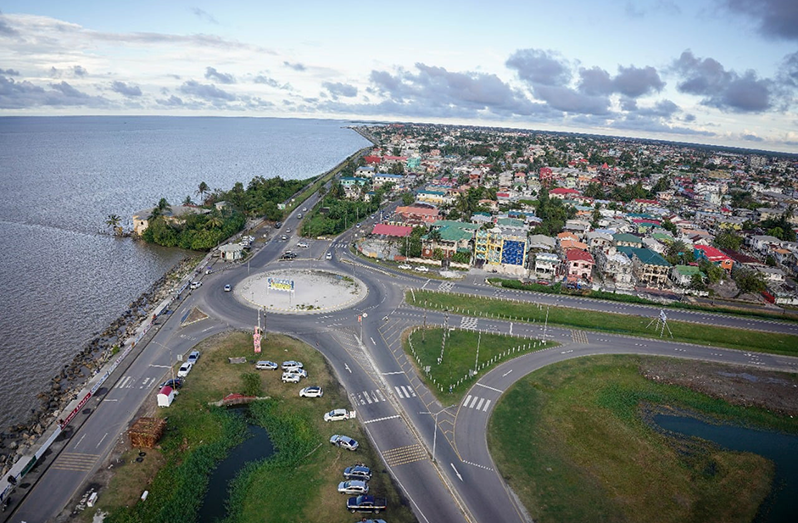
– IMF projects in new economic forecast report
GUYANA’s projected economic growth for 2021, measured by its real Gross Domestic Product (GDP), has doubled from 8.1 per cent to 16.4 per cent, according to the International Monetary Fund’s (IMF) World Economic Forecast years.
Earlier projections by the IMF indicated that Guyana’s GDP would grow 8.1 percent this year, building on the 26.2 percent real GDP growth forecast for 2020. But, in this 2021 Forecast, the IMF noted that Guyana’s GDP has grown 43.4 percent in 2020 and projected to grow 16.4 percent in 2021.
Real GDP is an inflation-adjusted measure that reflects the value of all goods and services produced by an economy (in this case Guyana economy) in a given year. Simply put, the real GDP measures a country’s total economic output, adjusted for price changes.
Presenting the 2021 National Budget in February, the Senior Minister in the Office of the President with responsibility for Finance, Dr Ashni Singh, noted that Guyana’s growth in 2020 was actually 43.5 percent. The revised IMF growth rate for 2020 (43.4 per cent) is now closely aligned with the figures provided by the senior minister. Meanwhile, in February, too, Dr. Singh said that in 2021, Guyana’s economy is expected to grow by 20.9 percent.
Looking ahead, the IMF projects that Guyana’s economic growth will continue. In 2022, the economy is expected to grow another 46.5 percent. By 2026, economic growth is expected to be around 3.0 percent.
Cumulatively, the Latin American and Caribbean region is expected to grow 4.6 percent in 2021, following the pitiful 7.0 percent contraction recorded in 2020 due to the implications of the COVID-19 pandemic. The recovery is expected to continue in 2022, with the region expected to record 3.1 percent growth. In 2026, that growth is forecast to be 2.4 percent.
On a larger scale, after an estimated contraction of –3.3 per cent in 2020, the global economy is forecast to grow at six per cent in 2021, slowing to 4.4 per cent in 2022.
The IMF, in its April report, asked that the impact of the COVID-19 recession be less severe than the 2008 global financial crisis, with the “unprecedented” policy response, leaving scars smaller than the 2008 global financial crisis.
“However, emerging market economies and low-income developing countries have been hit harder and are expected to suffer more significant medium-term losses,” the IMF noted. Guyana and the wider Latin American and Caribbean Region are part of this bracket.
The IMF also highlighted that output losses have been greater for those countries that rely on tourism and goods exports, and for those with limited policy space to respond.
SPECIFIC FOCUS
Meanwhile, as the worldwide vaccination campaign continues, the IMF stressed that country policies should first focus on escaping the COVID-19 crisis, prioritizing healthcare spending, providing well-targeted financial support and maintaining a monetary policy in monitoring financial stability risks.
The IMF suggested that as the recovery progresses, policymakers will need to limit long-term economic scarring with an eye toward boosting productive capacity (for example, public investment) and increasing incentives for efficient allocation of productive resources.
Last week, the World Bank noted that Guyana’s economy will maintain its positive growth trajectory over the next few years, largely due to the growing oil and gas sector. Based on the latest World Bank estimates, the country is expected to record economic growth of 20.9 percent at the end of 2021, 26.0 percent in 2022 and 23.0 percent in 2023.
It is important to note, however, that the ‘oil-free’ sectors of Guyana have been adversely affected by the COVID-19 pandemic, due to measures put in place to mitigate the spread of the new coronavirus and the effects of the COVID-19 pandemic. Dr. Singh said that during this year’s budget presentation, the economy’s non-oil sector contracted 7.3 percent.
The tourism, fishing, mining, forestry, manufacturing, services and construction sectors have all been affected by COVID-19 restrictions, resulting in reduced productivity. Small increases were recorded in the water supply and sewerage sector as well as in the electricity sector.
On Monday, during a virtual ministerial gathering on human capital, convened by the World Bank, Dr. Singh said that Guyana is still the fastest growing economy in the world and will remain among the fastest growing economies over the next few years.
The Senior Minister highlighted that Guyana is rich in natural resources, including oil, minerals, and forests that cover 85 percent of the country’s territory, making its economic outlook very promising despite COVID-19 and domestic political and it caused a sudden contraction in those who did not. -oil gross domestic product (GDP) in 2020. Before the pandemic, Guyana was forecast to grow a massive 86 percent in 2020.
But, even with the country’s prospects bright, Dr. Singh told the virtual caucus: “… we also face extreme vulnerabilities to climate change, as well as significant development challenges. We are well aware of the scale of these challenges. They include avoiding the resource curse, promoting a strong and competitive non-oil economy, addressing our infrastructure gap, and improving human development outcomes. “